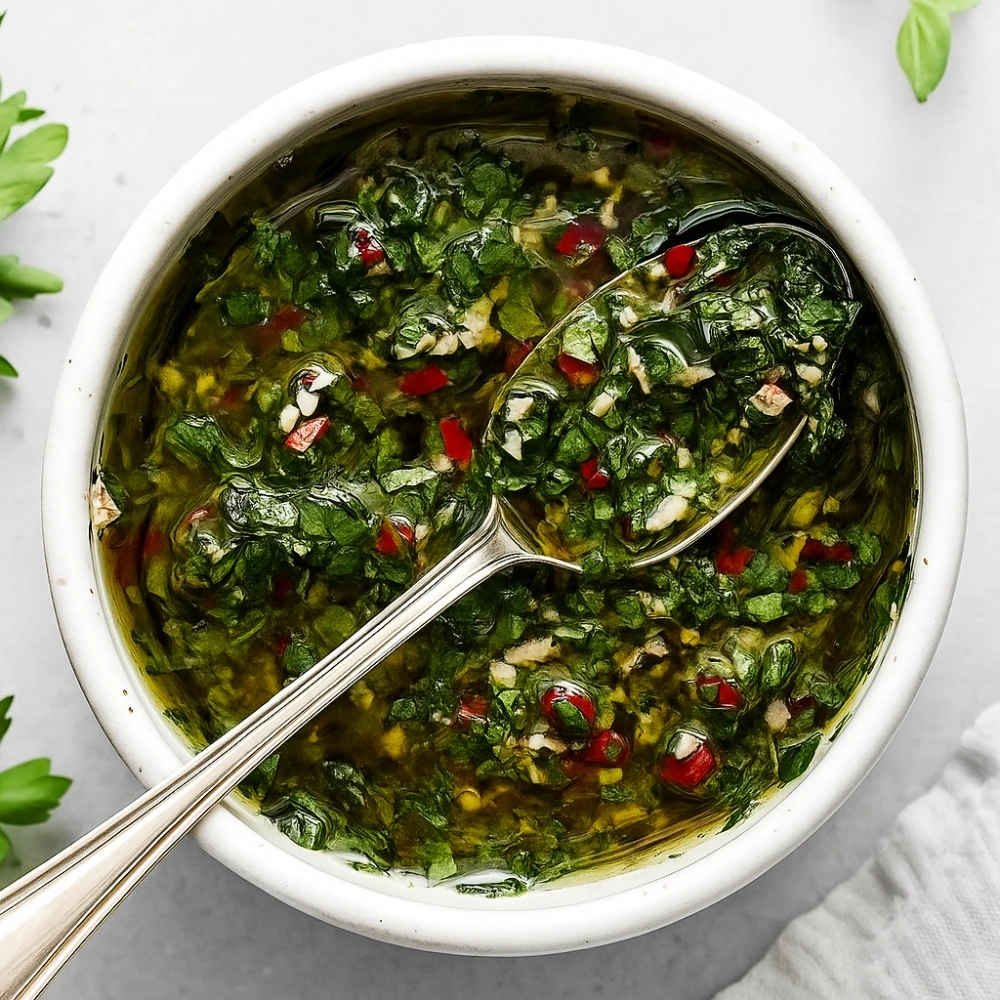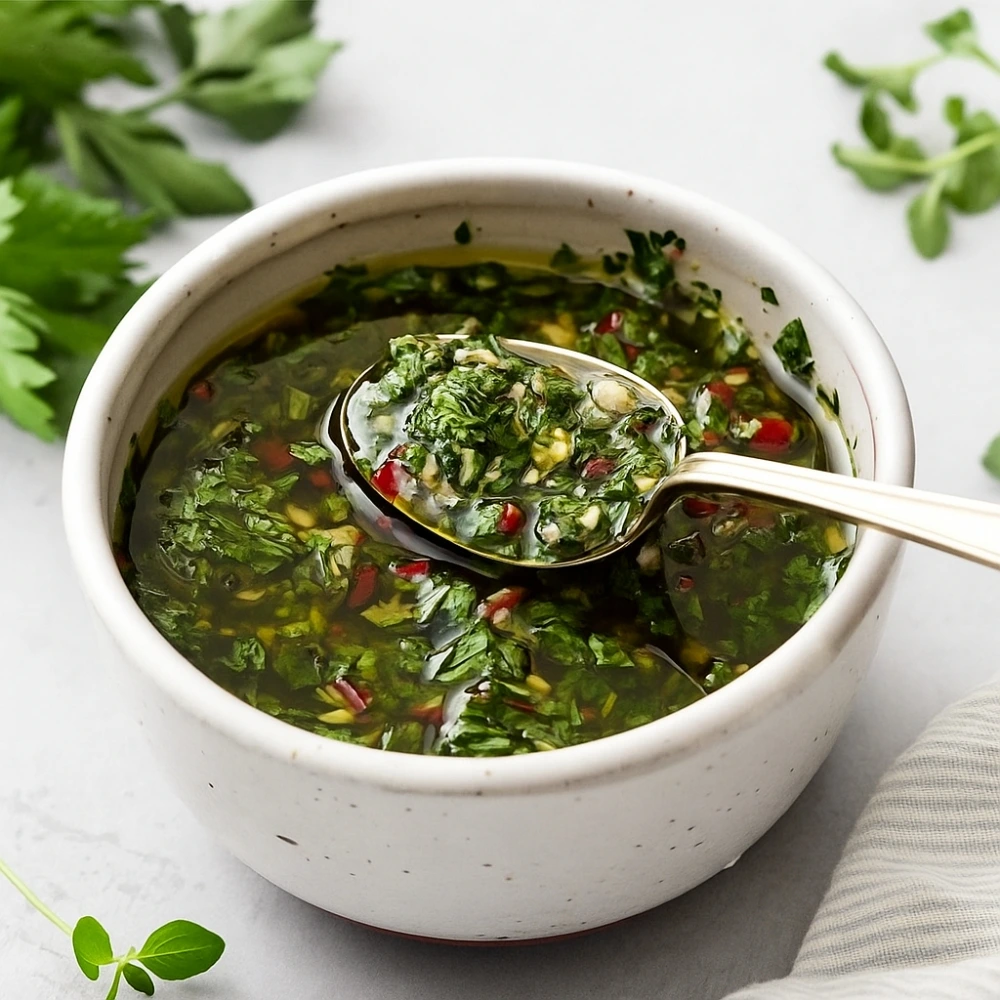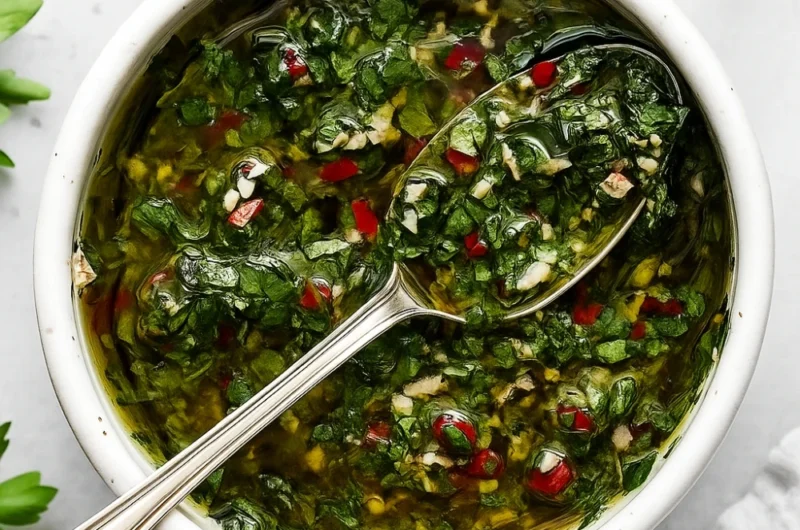The Best Fluffy Pancakes recipe you will fall in love with. Full of tips and tricks to help you make the best pancakes.
Guide to Authentic Chimichurri Sauce

Chimichurri sauce is Argentina’s beloved green herb sauce that combines fresh parsley, garlic, olive oil, and red wine vinegar into a zesty condiment that elevates everything it touches. This traditional sauce originated in Argentina and Uruguay, where it’s considered the perfect accompaniment to grilled meats, particularly steak.
The Art of Authentic Chimichurri
Creating the best chimichurri recipe isn’t just about mixing herbs—it’s about understanding the balance of flavors that has made this sauce a staple in Argentine cuisine for generations. Unlike store-bought versions, homemade chimichurri delivers fresh, vibrant flavors that simply cannot be replicated.
Cultural Origins and Historical Context
Chimichurri’s roots trace back to the 19th century in Argentina and Uruguay. Legend suggests the name comes from “Jimmy McCurry,” an Irish soldier who fought in Argentina’s wars of independence. However, most culinary historians believe it derives from the Basque word “tximitxurri,” meaning “a mixture of several things in no particular order.”
The sauce became synonymous with Argentina’s asado (barbecue) culture, where gauchos would prepare it to accompany their grilled meats over open fires on the pampas.
Essential Ingredients for Perfect Chimichurri
The beauty of authentic chimichurri lies in its simplicity. Here are the core chimichurri ingredients you’ll need:
Primary Ingredients
| Ingredient | Amount | Notes |
|---|---|---|
| Fresh flat-leaf parsley | 1 cup (packed) | Never use curly parsley |
| Garlic cloves | 3-4 medium | Fresh only, minced finely |
| Extra virgin olive oil | 1/2 cup | High-quality preferred |
| Red wine vinegar | 2 tablespoons | White wine vinegar works too |
| Dried oregano | 1 teaspoon | Mexican oregano is ideal |
| Red pepper flakes | 1/2 teaspoon | Adjust to taste |
| Salt | 1/2 teaspoon | Sea salt preferred |
| Black pepper | 1/4 teaspoon | Freshly ground |
Ingredient Deep Dive
Parsley Selection: Always choose flat-leaf (Italian) parsley over curly varieties. Flat-leaf parsley has a more robust flavor and better texture for chimichurri. The leaves should be bright green and fresh—avoid yellowing or wilted herbs.
Garlic Preparation: Fresh garlic is non-negotiable. Mince it finely by hand rather than using a garlic press, which can make the garlic bitter. For a milder flavor, you can briefly soak minced garlic in cold water for 10 minutes, then drain.
Oil and Vinegar Quality: Use the best extra virgin olive oil you can afford—it makes a noticeable difference. Red wine vinegar provides the traditional tang, but white wine vinegar or even apple cider vinegar can work in a pinch.
Traditional Method: How to Make Chimichurri
Follow this time-tested method for how to make chimichurri that rivals any Argentine steakhouse:
Step-by-Step Instructions
- Prepare the herbs (5 minutes)
- Wash and thoroughly dry the parsley
- Remove thick stems, keeping only leaves and tender stems
- Finely chop by hand—avoid using a food processor
- Mince the garlic (2 minutes)
- Use a sharp knife to mince garlic as finely as possible
- Sprinkle a pinch of salt over garlic and use the flat side of your knife to create a paste
- Combine dry ingredients (1 minute)
- In a medium bowl, mix chopped parsley, minced garlic, oregano, red pepper flakes, salt, and pepper
- Add wet ingredients (2 minutes)
- Pour in olive oil and red wine vinegar
- Stir gently to combine all ingredients
- Let it rest (30 minutes minimum)
- Allow flavors to meld at room temperature
- For best results, refrigerate for 2-4 hours before serving
Pro Tip: The key to great chimichurri is the knife work. Hand-chopping creates the ideal texture—food processors can make the sauce too watery and destroy the herb structure.
Chimichurri Variations to Explore
While traditional green chimichurri reigns supreme, these variations offer exciting flavor profiles:
Red Chimichurri (Chimichurri Rojo)
- Add 2 roasted red peppers (diced)
- Include 1 tablespoon tomato paste
- Reduce vinegar slightly to balance sweetness
Spicy Chimichurri
- Double the red pepper flakes
- Add 1 minced jalapeño or serrano pepper
- Include a pinch of cayenne pepper
Vegan Chimichurri
Our traditional recipe is already vegan! Simply ensure your olive oil meets your dietary requirements.
Quick Blender Chimichurri
Note: Only use this method if pressed for time
- Pulse ingredients in food processor 10-15 times
- Avoid over-processing to prevent a watery consistency

How to Use Chimichurri: Beyond the Steak
Uses for chimichurri extend far beyond its traditional pairing with grilled meats:
Main Dishes
- Chimichurri for steak: The classic pairing—drizzle over grilled ribeye, skirt steak, or flank steak
- Chimichurri with chicken: Excellent marinade or finishing sauce for grilled or roasted chicken
- Fish and seafood: Brightens grilled salmon, shrimp, or white fish
- Pork and lamb: Complements the rich flavors perfectly
Vegetables and Sides
- Drizzle over grilled vegetables (zucchini, bell peppers, eggplant)
- Toss with roasted potatoes or sweet potatoes
- Use as a dressing for grain bowls or salads
Creative Applications
- Mix into scrambled eggs or omelets
- Spread on sandwiches or wraps
- Use as a pasta sauce (thin with pasta water)
- Drizzle over pizza after baking
- Mix with mayonnaise for a flavorful spread
Storage and Shelf Life
Proper storage ensures your chimichurri maintains its fresh flavor:
Refrigeration
- Store in an airtight container for up to 1 week
- Cover surface with a thin layer of olive oil to prevent oxidation
- Bring to room temperature before serving for best flavor
Freezing
- Freeze in ice cube trays for portion control
- Transfer frozen cubes to freezer bags (up to 3 months)
- Thaw individual portions as needed
Storage Tip: Make a double batch—chimichurri actually improves in flavor after a day or two in the refrigerator.
Frequently Asked Questions
Why is my chimichurri bitter?
Bitterness usually comes from over-processing the herbs or using old garlic. Always chop by hand and use fresh ingredients. If using a food processor, pulse briefly rather than continuous blending.
Can I make chimichurri in a blender?
While possible, hand-chopping is strongly recommended. Blenders can break down the herbs too much, creating a watery consistency and releasing bitter compounds.
How long does chimichurri last?
Fresh chimichurri lasts 5-7 days in the refrigerator. The flavor actually improves after 24 hours as the ingredients meld together.
Can I freeze chimichurri?
Yes! Freeze in ice cube trays for easy portioning. Frozen chimichurri maintains quality for up to 3 months.
What’s the difference between chimichurri and pesto?
While both are herb-based sauces, chimichurri is vinegar-based and uses parsley, while pesto is typically basil-based with nuts and cheese. Chimichurri is also much more acidic and bright.
Can I substitute dried herbs for fresh?
Fresh parsley is essential for authentic chimichurri. Dried herbs won’t provide the same vibrant flavor or texture that defines this sauce.
Troubleshooting Common Issues
| Problem | Cause | Solution |
|---|---|---|
| Too oily | Incorrect oil ratio | Add more herbs and vinegar |
| Too acidic | Too much vinegar | Balance with more oil and herbs |
| Watery consistency | Over-processed herbs | Start over, chop by hand |
| Bland flavor | Old ingredients | Use fresh herbs and quality oil |
The Perfect Chimichurri Experience
Creating authentic chimichurri is more than following a recipe—it’s about understanding the balance of fresh herbs, quality oil, and bright acidity that makes this sauce so beloved. Whether you’re grilling the perfect steak or looking to elevate everyday vegetables, this traditional chimichurri recipe will become your go-to condiment.
The next time you fire up the grill or need to brighten a simple meal, remember that the best chimichurri comes from taking the time to hand-chop your herbs and using the freshest ingredients available. Your taste buds—and your dinner guests—will thank you.
Guide to Authentic Chimichurri Sauce
Course: SauceCuisine: American6–8
servings10
minutes00
minutes90
kcalIngredients
1 cup fresh flat-leaf parsley, finely chopped
½ cup fresh cilantro (optional, traditional versions use only parsley)
4 garlic cloves, minced
2 tablespoons fresh oregano (or 2 teaspoons dried)
½ cup extra virgin olive oil
2 tablespoons red wine vinegar
1 small red chili or ½ teaspoon red pepper flakes
Salt and freshly ground black pepper, to taste
Directions
- Finely chop the parsley, cilantro (if using), oregano, and garlic by hand or pulse briefly in a food processor.
- Place herbs and garlic in a bowl. Add red wine vinegar and chili or red pepper flakes.
- Slowly whisk in olive oil until well combined.
- Season generously with salt and black pepper to taste.
- Let the sauce sit for at least 15 minutes before serving to allow flavors to meld.
- Serve as a topping for grilled steak, chicken, fish, or roasted vegetables.

